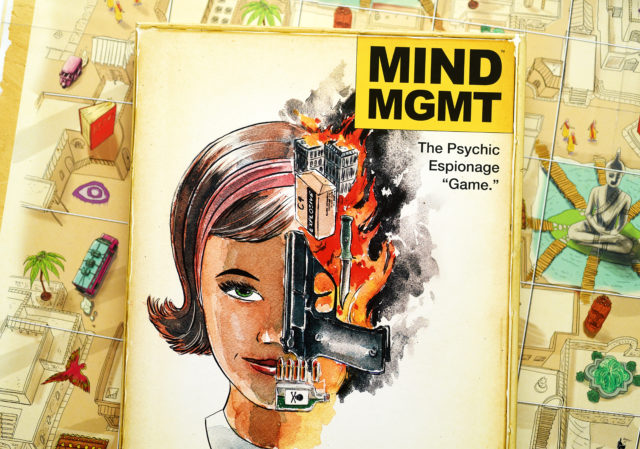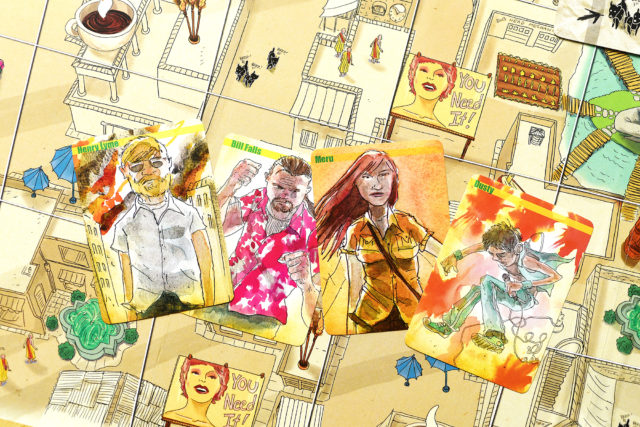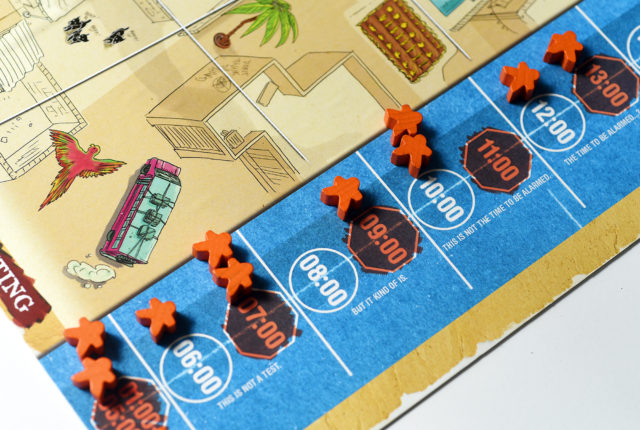I’ve always considered hidden movement or secret role games to be a bit like an inside joke. If you’re the traitors, or you know your space on the board, you have some knowledge that no one on the outside has. You can listen to them discuss the different possibilities, try to put themselves in your shoes, and try to elicit a response from you. But only you know the answers to the questions they’re asking. On the flip side, if you’re trying to smoke out the spies or find Mr X, it can be frustrating. Each time you try and make an accusation and fail, or land of a spot just to find you were a turn too late, it stinks. You’re playing the best you can, but you don’t have all the information. That makes victory in one of those roles so much sweeter.
I was pumped to try MIND MGMT for a number of reasons. First, it came with a pretty sweet design pedigree. Jay Cormier and Sen-Foong Lim have collaborated on some phenomenal games in the past, including Belfort, Akrotiri, and But Wait, There’s More. Secondly, it was a new iteration of one of my favourite styles of games, hidden movement. I got my first chance to play it with Sen at ProtoTO in Toronto this year.

MIND MGMT is based on a comic written and illustrated by Matt Kindt. The premise revolves around a secret government organization that uses psychic powers to accomplish its goals and the rogue agents that are trying to bring it down. I hadn’t heard of the comic before playing the game, but after a bit of research, it’s on my list of books to check out.
In the tabletop version, one player becomes the Recruiter for the underground agency. Their goal is to move around the city making contact with potential new agents. The other other players are former agents that are fighting to take down MIND MGMT. They are trying to locate the Recruiter as they move invisibly through the city.
The city is quite a bustling place and it’s broken up into a 6×7 grid. Each space has two different features on it, like subliminal billboards, thought-shield umbrellas, Reconnaisance birds, Hallucinogenic torches, etc. Aside from being part of the daily life of the city, these features represent hiding places of potential recruits that the Recruiter may want to contact during the game. They secretly choose their starting space then take three Recruitment cards that indicate where the people they want to get in touch with might be hiding. On their own personal dry-dry-erase map of the board, the Recruiter can mark off all of the five occurrences of the three features around the city. This gives them a goal to work towards. The Recruiter gets a bit of a head start making their first four moves of the game before the Rogue Agents trying to track them down enter the scene.

Rounds alternate between Rogue Agents and the Recruiter taking turns. The Recruiter marks their progress on the secret board. It’s possible for them to be on the same space as one of the Rogue Agents. It’s actually likely. Agents on their turns can move up to two spaces orthogonally. They can also ask about one of the features on their current location. If the Recruiter has been on a space with that feature during the game, they have to put a Step token down on the board. If they have been on multiple spaces with that feature, they can choose which they they mark. One interesting aspect of the game are the Mental Notes. Rogue Agents can place them in a space when the Recruiter has indicated they’ve been there. The Mental Note reminds Agents when the Step token was placed. At this point, the Mental Note is considered ‘unconfirmed’. If an Agent is on a space with a Step token, they can take a Reveal action. The Recruiter must indicate what turn they were on that space by placing a ‘confirmed’ Mental Note there. As more Mental Notes enter the board, players can start to plot the route of the Recruiter and predict where they might be next. Finally, the Agents can attempt a Capture. If they are on the same space as the Recruiter, they nab him and win the game.

Agents are all characters from the series and have special abilities. Meru has the Psychic Crosshairs. She can ask if the Recruiter is in any of the nine spaces indicated by her card, or Dusty with his Neuro Rhythm. It allows him to move other Agents.
After each round (which represents two hours in the game), the Recruiter indicates how many agents they contacted, I.e. how many features that match their Recruitment cards they passed over during the round. To help them out, the Recruiter has Mind Slip cards which can be used to get them out of a jam. If they have a Mind Slip token, they can spend a card to move and couple of space orthogonally or diagonally.

The Recruiter wins if they have collected nine new recruits, or if they can make it a certain number of rounds without being caught.
That is a very brief overview of the rules in the ‘training mission’ in the game. The full game adds all sorts interesting twists like Mayhem tokens, which act as walls between some of the spaces in the city, and Immortals, who work with the Recruiter, moving around the board at their command.
So, full disclosure I have only played the training mode of MIND MGMT. I got in a couple rounds before my ability to arrange a game night suddenly and completely disappeared for some reason… Never the less, I wanted to get my thoughts out. The Kickstarter runs until April 3 and they have already almost 300% funded. The pledge looks pretty sweet right now, with upgraded bits and a cool Game Trayz insert.
I love the Matt Kindt art and I’m a sucker for one-vs-many hidden movement games. Jay and Sen created a game with a really cool approach to a fun mechanism. Check out the campaign here if MIND MGMT sounds interesting to you.
Comments
No comments yet! Be the first!